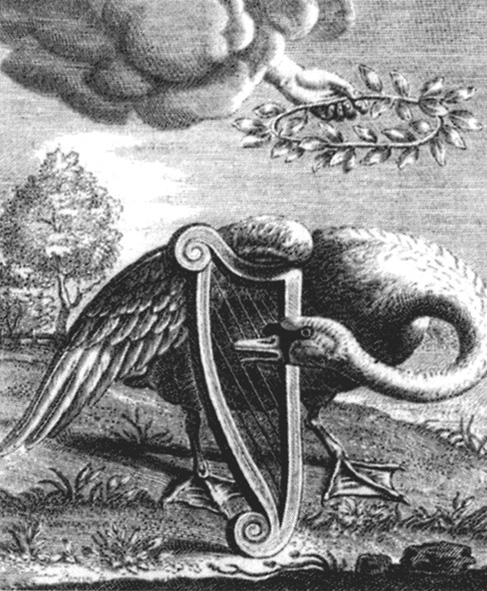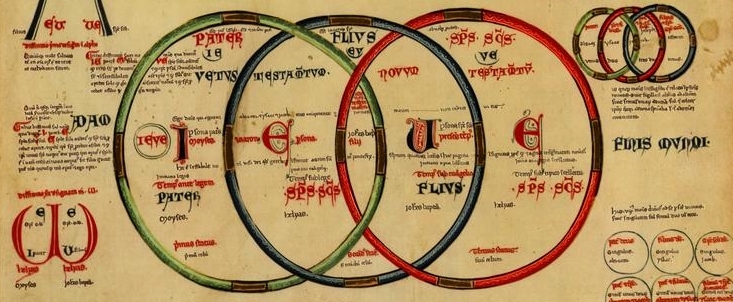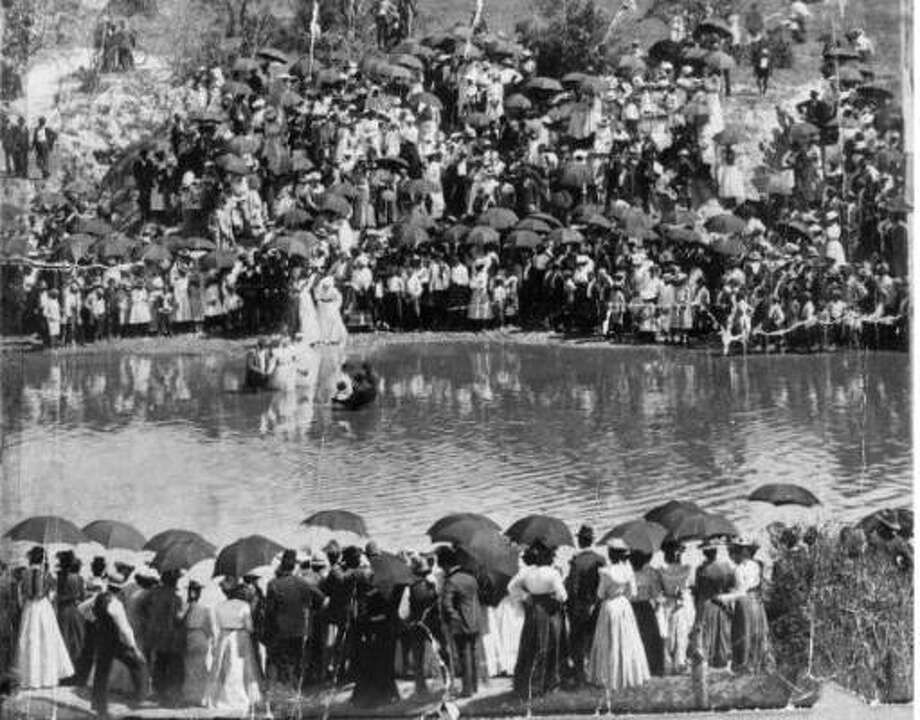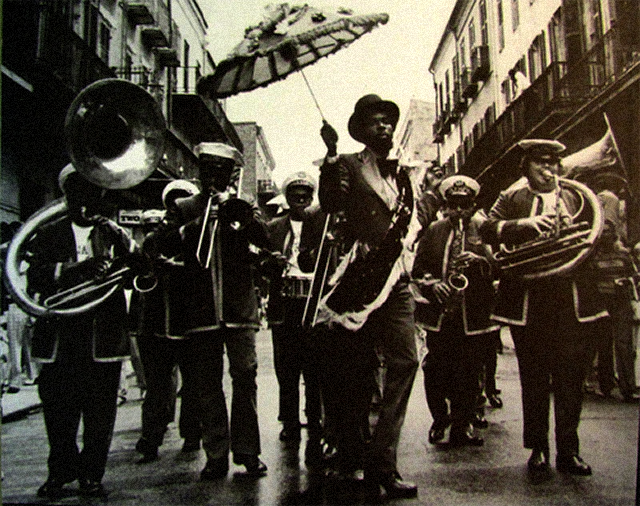
Menard has (perhaps unwittingly) enriched the slow and rudimentary art of reading by means of a new technique -- the technique of deliberate anachronism and fallacious attribution. That technique, requiring infinite patience and concentration, encourages us to read the Odyssey as though it came after the Aeneid, to read Mme. Henri Bachelier’s Le jardin du Centaure as though it were written by Mme. Henri Bachelier. This technique fills the calmest books with adventure. Attributing the Imitatio Christi to Louis Ferdinand Céline or James Joyce -- is that not sufficient renovation of those faint spiritual admonitions?
-- “Pierre Menard, Author of the Quixote,” Jorge Luis Borges
Pierre Menard’s novel and radical technique for the art of reading, involving deliberate anachronism -- reading a work of literature as if it was published after the works it had itself influenced -- and fallacious attribution -- reading a work of literature as if it was penned by a different author entirely -- can itself be radicalized.
Not only can new and powerful insights be gained by reading Gilgamesh, for example, as if it was written by Nietzsche, or by reading the Old Testament as if it was influenced by the Mabinogion, but even more can be discovered if all texts everywhere and at all times were accepted as being written simultaneously.
By applying this method, Cervantes’ Don Quixote and Menard’s Don Quixote have been both written and released at the same time, as have been all other texts. Not anachronism but synchronism. The lines of influence are omnidirectional and omnipresent, converging and diverging at every point. And this simultaneity of textuality can only take place at the very present of reading. Indeed the act of reading creates all texts. And of course this includes the entirety of history: the whole of humanity’s written account of itself. This corresponds to Blake’s 6000 years of creation compressed into the pulsation of an artery.
The holy scriptures of every religion, every scientific treatise, every technical manual, every bit of back-of-the-envelope doodling, every pulp novel, every newspaper headline, every Shakespeare play, every song, every script, every poem, every toilet stall wall scrawling, in any language ever, all of it inter-reflects, flows in and out of each other, each line, word and letter functioning as fluctuating portals into the whole.
And, riffing on McLuhan, why should this be limited only to the medium of print? There is also the simultaneity of the electric and electronic media. All produced sounds and images coalesce and fracture, absorb and bounce off one another, swirl and dance together at once. Yet the media are only particular extensions of our nervous systems and senses. All technologies, all tools, all built things and environments, are also right here simultaneously, each extending different parts of our own physical form.

We “read” them as we move our bodies within them. But as they are extensions of our own physical forms, these bodies, our bodies, are cells of a greater body that contains all people. We are healthy together. We are sick together. We are both sick and healthy. But no quarantine or isolation is absolute. The membranes between bodies are porous, permeable, undulating, occasionally vanishing.
The tympanum vibrates on both sides. The margin may also be a centre. Nothing is prevented from leaking across.
From bat to shit to fly to pangolin to pandemic. Caravans, migrations, rats, coughs, panic. Delving too deep. Cutting across the kingdoms. Fluidity of all categories. Seasickness in every cell. Supply chain disruptions. General schizophrenic blowouts. A concrescence of all symbols and species. Secrets of the ziggurats in the condensation patterns outside a stainless steel water cup. Biolab, cruise ship, death cult, ping pong club, school lunch, NASCAR race, taxi cab ride, rest home.
Fine meridians, too subtle to detect empirically, grant dispersion of disruption. Both internal and external dis-ease. No clear foundations, no firm conclusions, no possible predictability. The whale is just a whale. At this moment nothing is filtered out. The sunshine glares, almost blinds, eyes watching at every corner, shut down, barricaded, rock piles, shimmering, quavering, breaking at the edges. A virus is only barely biological and the coming plague will be even more ephemeral. A contagion of punning tricksters streaming from the volcanic fire.
As revealed in the most blasphemous of the Hermetic verses, the imagination is godlike. In Book 11 of the Corpus Hermeticum, initiates are advised to practice a visionary exercise. The faculty of the imagination already provides us with the power to transport our souls anywhere, to transform them into anything, to soar even beyond the cosmos. And all with the speed of thought. With this remarkable power we have the ability to begin to understand the mind of God, as only Like understands Like.
Grow to immeasurable size. Be free from every body, transcend all time. Become eternity and thus you will understand God. Suppose nothing to be impossible for yourself. Consider yourself immortal and able to understand everything: all arts, sciences and the nature of every living creature. Become higher than all heights and lower than all depths. Sense as one within yourself the entire creation: fire, water, the dry and the moist. Conceive yourself to be in all places at the same time: in earth, in the sea, in heaven; that you are not yet born, that you are within the womb, that you are young, old dead; that you are beyond death. Conceive all things at once: times, places, actions, qualities and quantities; then you can understand God.
-- The Corpus Hermeticum: Book 11, Verse 20
This passage makes clear that not only can we transmute ourselves into any form through the imagination, but through it we can do something that we cannot do with logic or reason alone. We can inhabit many places in a single instant, in fact all places. We can exist simultaneously at every position. We can encompass every contradiction, every opposite. We can be both A and Not-A. We can become impossible.
The soul, the psyche, is already ubiquitous, omnipresent and so potentially omniscient. Logical paradox is its playing ground. Even death is not a barrier. The field or vortex of simultaneity that opens up through Menard’s playful echo swallows up everything, conceivable and not.

This virtue of the imagination, regardless if it is activated by external substances or if it arises “naturally” through purely internal faculties or techniques, is precisely why we are said to be “created in the image of God.” God has no fixed and apprehendable physical form so it is with the virtue of our minds that we resemble Him/Her/It. We were made in the image of the One who creates images, One who imagines. As Coleridge explains:
The imagination then I consider either as primary, or secondary. The primary imagination I hold to be the living power and agent of all human perception, and as a repetition in the finite mind of the eternal act of creation in the infinite I AM. The secondary I consider as an echo of the former, coexisting with the conscious will, yet still as identical with the primary in the kind of its agency, and differing only in degree, and in the mode of its operation. It dissolves, diffuses, dissipates, in order to re-create; or where this process is rendered impossible, yet still at all events it struggles to idealize and to unify. It is essentially vital, even as all objects (as objects) are essentially fixed and dead.
-- Biographia Literaria, Chapter XIII, Samuel Taylor Coleridge
The primary imagination -- the infinite I AM within our own perceptual I am -- blurs almost seamlessly into the secondary. It is difficult to distinguish between the two. The second is an “echo” of the first, as Menard echoes Cervantes, yet still identical. The creative process repeats itself in a continuous pulse, circling back upon its “origin,” making it unclear where one creation ends and the other begins. A repetition which becomes a reenactment of the proto-cosmic “Let There Be Light.”
Yet Coleridge did contrast these two types from what he called “Fancy,” which is “no other than a mode of memory emancipated from the order of time and space,” mixed and affected by sensory impressions and the words they are expressed by.
Fancy is simply a modification or a tweaking of the world as it is; a new world does not emerge. Most of what distracts or entertains us, including the NEWS, our entire “consensus reality,” is a product and example of Fancy. In Blake’s terms, it is the perceptual system that we are enslaved by. Yet it is only another facet of the I AM and subject to constant uncontrolled transformation and occasional dissolution, as is happening globally right now.
I said the sense “stories about fairies” was too narrow. It is too narrow, even if we reject the diminutive size, for fairy-stories are not in normal English usage stories about fairies or elves, but stories about Fairy, that is Faerie, the realm or state in which fairies have their being. Faerie contains many things besides elves and fays, and besides dwarfs, witches, trolls, giants, or dragons: it holds the seas, the sun, the moon, the sky; and the earth, and all things that are in it: tree and bird, water and stone, wine and bread, and ourselves, mortal men, when we are enchanted.
J.R.R. Tolkien, in his essay “On Fairy Stories,” is more sympathetic than Coleridge to Fancy, which Tolkien takes as a dismissive and diminutive form of the earlier and more commanding term “Fantasy.” Fantasy is created through the modification of simple words, through poetry itself, and it does involve a mere alteration of this world, “the Primary World,” which presently appears to our senses and is apprehended by our thought.

But one gets the sense, reading his essay, that what Tolkien has in mind is something quite different than what Coleridge devalued as Fancy. This is something that involves a far more active involvement of the imagination, something much closer to the primary or secondary imagination.
Yet in Tolkien’s terminology, a Secondary World branches off from the Primary World when it opens up, and/or is opened up, into “enchantment.” Faerie is his name -- the old name -- for this “realm or state,” (implying that it can be experienced externally and internally, or both simultaneously), and it is here where the folk and creatures of myth still dwell.
And in this Land, fairies of all sorts have not shrank, like Fancy, to shadowy or childish insignificance, but are life-sized, warm and breathing, beautiful and terrifying. They continue as Fantasy. But exotic beings are not the only things that inhabit Faerie. Our whole world might be contained within it, but it too becomes enchanted.
Enchantment produces a Secondary World into which both designer and spectator can enter, to the satisfaction of their senses while they are inside; but in its purity it is artistic in desire and purpose. Magic produces, or pretends to produce, an alteration in the Primary World. It does not matter by whom it is said to be practiced, fay or mortal, it remains distinct from the other two; it is not an art but a technique; its desire is power in this world, domination of things and wills.
Enchantment is here contrasted with Magic, and the latter did not have a positive connotation for Tolkien. By enchantment we create, or at least stumble into, a Secondary World that is as realistic as anything we witness from day to day. Our senses are satisfied by it -- we do not doubt what we see -- and Tolkien wrote that we can enter into it “bodily,” with our physical form in tact. This is no longer just an imaginative or spiritual exercise, as it is in the Hermetic writings, but it is a voyage of exploration, a trip.
But enchantment, a chanting or singing of the world, is created solely for the sake of art, for the sake of beauty and wonder. It is an expression of power -- and it is highly powerful -- but it’s not a desire for the attainment of power over others. Enchantment is only effective if its intention of creation for the sake of creation is pure. If it is not pure it ceases to be enchantment and it passes over into magic.
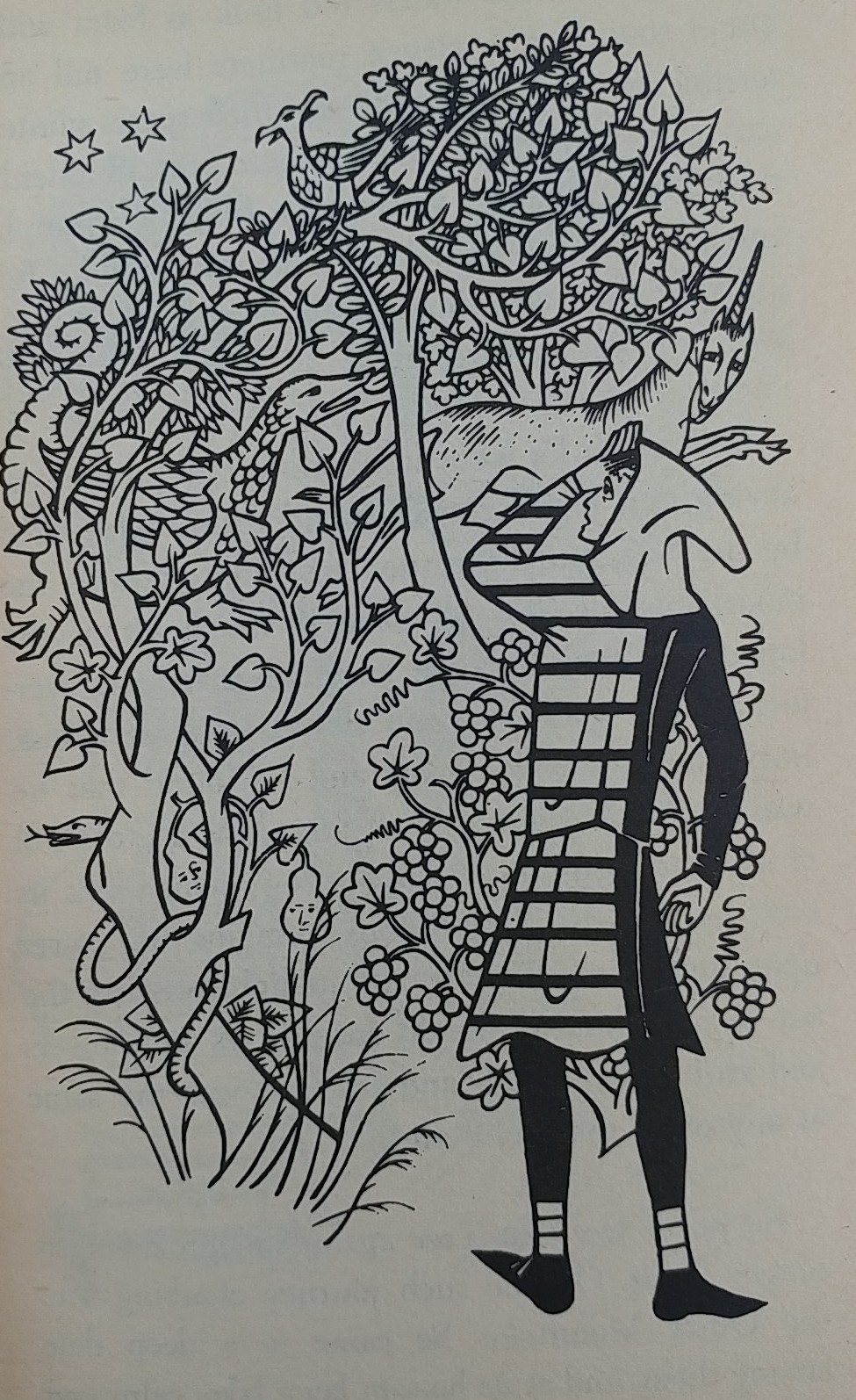
Magic, and we can think of Sauron or Saruman here, is the willed alteration of the Primary World in order to gain domination over others. It is a pretense, a simulation, a spell or a web to trap or confine. It is Fancy in its negative sense. It is the consensus reality, though by no means a consensus, that tries to claim primacy over the Primary World. It is as if Menard tried to erase all traces of Cervantes as the author of the Quixote and claimed that he himself was the original Master.
Evidently this world, the world of enchantment, and the world of magic, occasionally fade into one another. Direct doors from one world to the next may open up now and again, but more often, when something this singular does happen, one world just melds or drifts into another, like a cinematic montage or an anatomical overlay in an old medical text. You’re walking through the woods or down the street and suddenly the landscape shifts into Lothlorien or Mordor.
And in fact fairy-stories deal largely, or (the better ones) mainly, with simple or fundamental things, untouched by Fantasy, but these simplifications are made all the more luminous by their setting. For the story-maker who allows himself to be “free with” Nature can be her lover not her slave. It was in fairy-stories that I first divined the potency of the words, and the wonder of the things, such as stone, and wood, and iron; tree and grass; house and fire; bread and wine.
-- “On Fairy Stories,” J.R.R. Tolkien
Familiar objects, simple things and movements and shapes and colours, take on a potency which they always possessed but we never noticed before. They are made luminous.
And -- getting back to the initial technique or method -- on the road towards enchantment, or willingly letting oneself become enchanted, or even in the growing recognition of the current bonds of the dominant magic, we head towards the point of total simultaneity, towards the maximal compression of both novelty and meaning (though these two are inseparable by definition).
Things increasingly reflect off of other things. The web of correspondences is constricted as we spiral into the centre of mandalic integration. Salience attains ultimate density, though nothing ceases to move, nothing loses its unique spark.
...Every person, place and thing in the chaosmos of Alle anyway connected with the gobblydumped turkery was moving and changing every part of the time...
-- Finnegans Wake, James Joyce, p. 118
This is, in fact, the anti-Borg. Perfected and rigid order -- the crystalline Cosmos -- is revealed as being incomplete and rather stale and boring compared with this speck or scintilla of total potency and potential. Cosmos enfolds out of Chaos, this last being the true Mother of All Things. Simultaneity is just another of her million names.
Cosmos is the realm of Magic, and the Primary World and the Primary Imagination is merely the first act -- as it is held to be by the Gnostics -- of simulative, malignant magic. Enchantment is the lost road which takes us through the original point of “Creation,” the Original Sin.

When we peek through this kaleidoscope, every shard of matter and psyche shakes and shimmies, refracts and resonates, rings out with all senses, falling respectively into shadow and back into light. This point (of the compass of Yahweh and Newton), being all points, opens up everywhere onto the First Time which is every time.
Through repetition of the cosmogonic act, concrete time, in which the construction takes place, is projected into mythical time, in illo tempore when the foundation of the world occurred. Thus the reality and the enduringness of a construction are assured not only by the the transformation of profane space into a transcendent space (the center) but also by the transformation of concrete time into mythical time.
-- Cosmos and History, Mircea Eliade
As Eliade explains, “primitive” tribal societies orient their sense of time and space, of the entire world that they inhabit, on the perpetual or eternal ritual reenactment of the original and singular cosmogonic event: of the initial emergence of Cosmos from Chaos or, from another angle, their wedding rites.
The tribal perception of time is not linear, or even cyclical, but simultaneous. When tribal members are performing these rituals they arrive back in illo tempore, back in the “once upon a time” of undiluted fairy tales. The wholly transcendent time and space, the point of simultaneity, is fully experienced here on this Earth, which has become enchanted, mythical, in its deepest sense.
The questions of where or how this takes place is really unimportant. Whether the experience is internal/mental or external/physical is meaningless when it involves a realm or state in which all contraries are conjoined.
Historical civilizations, on the other hand, people who have entered history, people who have separated their Book -- all books -- from their world, took on a more and more detached view of time. Starting with the primal point of points, this image was widened into a wheel or a cycle, and then the ascent of this cycle was segmented and flattened into a separate line. Point to circle to line.
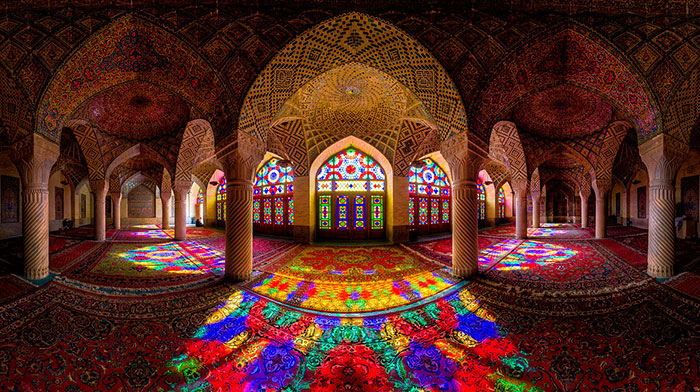
At first this line was envisioned to have a near vertical incline, along with the hope of some summit or transcendent end. But as history drifted from modernity to postmodernity and beyond, the line became virtually horizontal, flapping this way and that, randomly making its way to nowhere. The one line began to fray and disintegrate. This viral present.
But the old Book, or books, still promised a single point from which it all had emanated and into which it would all return. Yet the course through the stars to get back to this origin is illuminated by the imagination.
Between the world of pure spiritual Lights (Luces victoriales, the world of the ‘Mothers’ in the terminology of Ishrāq) and the sensory universe, at the boundary of the ninth Sphere (the Sphere of Spheres) there open a mundus imaginalis which is a concrete spiritual world of archetype-Figures, apparitional Forms, Angels of species and of individuals; by philosophical dialectics its necessity is deduced and its plane situated; vision of it in actuality is vouchsafed to the visionary apperception of the active Imagination.
-- The Man of Light in Iranian Sufism, Henri Corbin
The space/time sense of Sufism, which Corbin describes here, is cosmological and cyclical. Within this paradigm, one only approaches the primitive heights and depths of the eternal present when one does enter into the mundus imaginalis. We find it in the Ninth Sphere, beyond the Fixed Stars, but not yet within the ever-burning Empyrean of pure Spirit.
Intellectual archetypes take on a kind of flesh here. It is the realm of angels and daemons. Spirit swirls with Matter. This may be the Secondary Imagination. This may be the realm of Faerie. This may be the locus of Finnegans Wake.
The texts are all being conflated in my essay, badly misread and juxtaposed, because in simultaneity all is being ground together, all examined at once without contradiction. This is the Method, our post-Menard literary technique. We read to become free.
But when we have travelled through the kaleidoscopic mundus imaginalis, when we have plunged into the Inner Fire, we find that it is just(!) a prick back into Chaos. The world-system turns inside-out. The middle of the doughnut twists and enfolds out to the ring. Then once again we're at the centre of the Earth, at the lowest depth of Hell, at the tip of Satan’s erect cock.

All is inverted and disoriented, and the intricate order of the crystalline concentric spheres, resounding with celestial harmonies, shatters in a second, and we’re back here typing, scrolling, turning pages, looking out onto our day.
Well, I wonder how any poet could be attracted to Jungianism. To me poets use symbols to be initial and in the universe. Jung uses them to be in a psyche and around a center. When we, from my generation, were looking into the universe, there wasn’t that apparent a center in time or space. Charles [Olson] had the same observation. But the distinction between a centered universe and a non-centered one never bothered him. He took the center to be wherever you are. Anyway, I am not a creature of the center. I am a creature of outside.
-- Towards a New American Poetics, Robert Duncan interview
Robert Duncan points out that even Jung’s resolution of the question of where is the true centre, is too easy, to pat. “The centre can be found in the psyche.” But where is this? Jung teaches that the pysche contains both the consciousness and the unconscious, the light and its shadow, the Sun and the Moon. Yet Jung further explains that the unconscious has no discernible border; it blurs the individual and the collective. It may have no limit. In fact, the personal psyche or soul and the World Soul might be identical, and we find just this teaching within traditional societies from China to the Amazon.
So to reach this centre, to integrate or individuate, is to once again find God. And where is He? Duncan answers that the poets always insist on the particular, not the general or the archetypal. The tree in your backyard doesn’t represent the World Tree, it is It. The distinction might seem petty, but it really isn’t. One is a search for a Centre, although the spheres are no longer in the stars but within our mind, and the other is the acceptance that the centre is everywhere and/or nowhere.
Duncan’s heresy is greater than Jung's, and his fellow poet Charles Olson even more so because Olson could care less one way or the other. Heresy is orthodoxy is heresy. No-centre is the centre. But in any case the way is disorienting, nauseating, feverish, uncanny. These are symptoms of the disease.
...I just kept reading both pieces over and over again, trying to detect at least one differing accent or letter, wanting to detect at least one differing accent or letter, getting almost desperate in that pursuit, only to repeatedly discover perfect similitude, though how can that be, right? If it were perfect it wouldn’t be similar it would be identical, and you know what? I’ve lost this sentence, I can’t finish it, don’t know how--
Here’s the point: the more I focused in on the words the farther I seemed from my room. No sense where either, until all of a sudden along the edges of my tongue, towards the back of my mouth, I started to taste something extremely bitter, almost metallic. I began to gag.
-- House of Leaves, Mark Z. Danielewski
This is Johnny Truant in House of Leaves trying to make sense of old man Zampano’s "Navidson Record" manuscript in which Cervantes’ Don Quixote is quoted, followed by an identical quote from Pierre Menard. This gets us back on the track of the initial inquiry, and a return to the explanation of the technique or method. Johnny, who obviously hasn’t read Borges, cannot by any means understand how the two texts are in any way different.

And he is right. They are identical. Except Menard’s book is an echo of Cervantes, and this changes its significance altogether. All of human history since the time of Cervantes is therefore contained, as shadow knowledge, in Menard’s work. This is Menard’s genius, but Johnny does not get it. Or maybe he does?
Perhaps he is already reading from the point of view of simultaneity, where all texts appear at once, but he doesn’t know it yet. And this torments him. The lost centre he experiences attempts to return as a Shadow, as pure evil, as the Minotaur, and he experiences this as extreme physical and emotional suffering.
In House of Leaves, every reference to the Minotaur and its story is typed in red and stroked out, under erasure. Zampano has stricken it from his manuscript, and it reappears only as a absence in Johnny’s edition. Yet it also appears as a real terrifying presence to both -- slash marks on Zampano’s wooden floor at the scene of his death, creeping in as a metallic taste and spiralling out into an unendurable nightmare of nausea and horror to Johnny.
Just as Minos could not possibly have constructed a labyrinth big or complex enough to contain his aborted and malformed son, so the gaping centrepoint of all creation -- Chaos herself -- will necessarily arise to haunt and overwhelm any self-styled Creator: be he author, king or God.
...Which is doubtless to recall that beyond the philosophical text there is not a blank, virgin, empty margin, but another text, a weave of differences or forces without any present center of reference (everything -- “history,” “politics,” “economy,” “sexuality,” etc. -- said not to be written in books: the worn-out expression with which we appear not to have finished stepping backward, in the most regressive argumentations and in the most apparently unforeseeable places); and also to recall that the written text of philosophy (this time in its books) overflows and cracks its meaning.
-- “Tympan,” Margins of Philosophy, Jacques Derrida
This essay by Derrida is also quoted in the "Navidson Record," in the House of Leaves, and in the House of Livres. Tympan is the tympanum, the eardrum, the vibrating membrane that allows us to apprehend sound. In a sense, this membrane is a margin, the border of a room or a body or a text. But as a border or limit it vibrates on both sides. Does it vibrate from within or without? This is impossible to determine. The sounds ripple in both directions.
No text is thus perfectly contained, all is cracking and overflowing. A barrier can be crossed, one can move from one room of the labyrinth or house to another, but no complete structure can ever be mapped, no structure can ever be completely mapped. The textual categories, subjects or fields, which we overlay onto our “knowledge” with the hope of projecting a semblance of order, are themselves leaky, decentred, liable to suddenly morph one into the next.
Where is the centre in this Library of Babel? Is it at the point of maximal meaning or at the point of total nonsense? Yet how can either be determined? Where is the nexus or Archimedean point, perhaps outside of the Cosmos, from which we can stand on solid ground and judge?
And who are the Judges? Who are the Grand Conspirators? Who are these omniscient and omnipotent beings who can successfully plot all outcomes when, as we have seen, even the gods, even the Supreme Deity, delude themselves in thinking that they have mastered Chaos?

A membrane, even a wall or fortress, is no hurdle for a virus. Neither is it limited by the categories of hoax or not hoax. It doesn’t care if it is believed in or not. It functions beyond the dichotomy of presence and absence. It is the suppressed centre/margin reappearing everywhere simultaneously, the Minotaur rampaging just beyond every corner, in our very lungs, exponentially replicating itself
“A weave of differences or forces without any present center of reference.” And, paradoxically or not, the traces of this, this opening into Faerie, enchanted and/or magical, can be found in even the most common of nooks and crannies.
Under the step, toward the right, I saw an iridescent sphere of almost unbearable brightness. At first I thought it was spinning; then I realized that the movement was an illusion produced by the dizzying spectacles inside it. The Aleph was probably two or three centimeters in diameter, but universal space was contained inside it, with no diminution in size. Each thing (the glass surface of a mirror, let us say) was infinite things, because I could clearly see it from every point of the cosmos. I saw the populous sea, saw dawn and dusk, saw the multitudes of the Americas, saw a silvery spider-web at the center of a black pyramid, saw a broken labyrinth... saw the Alelph from everywhere at once, saw the earth in the Aleph, and the Aleph once more in the earth and the earth in the Aleph, saw my face and my viscera, saw your face, and I felt dizzy, and I wept, because my eyes had seen that secret hypothetical object whose name has been usurped by men but which no man has ever truly looked upon: the inconceivable universe.
-- “The Aleph,” Jorge Luis Borges --
In “The Aleph” Borges moves from an infinite Library of texts where a centre is impossible to discern to a common basement step where the entire universe is contained in a single Centre. And yet these “spaces” are the same.
The Aleph is simultaneity; it is the chaosmos of Alle. It contains all movement and yet this is merely “the illusion produced by the dizzying spectacles inside it,” the moving image of eternity. It is the instant, the scintilla, of the creation of cosmos from chaos. It is “Aleph” because it is the start, the origin, Keter the Crown, but it is only this from our own linear time-based perspective, from our own tunnel visions.
Ancient peoples re-witnessed this moment at the turnover of the grand cycles, archaic peoples, earlier and for longer still, were able to participate within it at nearly any point. It is in the grass, in the sparkle of sunlight on a pond, in the flash of a bird’s wing, at the birth of a child. For us, the timeline whipping like suddenly released reins, the Aleph’s shadow or glimmer reaches back to us from the End.
This, Borges calls the Secret Hypothetical Object, McKenna the Hyperdimensional Object, Couliano the Ideal Object, Yeats the Second Coming. It is now, at this singular moment in “history,” very much in view.
It is both cellular and geopolitical, both biological and metaphysical, both singular and contagious. Again, the categories blur. All efforts to contain it, or to deny it, soon become it, are already enveloped by it. There is a widespread sense, finally, that it is starting to transform everything.

And Borges, like the joker he is, does another number on us. We find out, later in the story, that there is another Aleph, at another inconspicuous location, but that this one might be a FALSE Aleph, an anti-Aleph as it were.
But how would this latter be any different from the first? How would we ever begin to discern precisely how it might be different? And would it matter? Wouldn’t they necessarily be identical? If the Aleph contained all things wouldn’t it also contain the Anti-Aleph? And wouldn’t the opposite hold true as well? Or is one just the echo of the other, both caught in the weave of differences?
Do the two represent two opposing sides of the universe, God and anti-God, totalitarian global bio-police state and decentralized jubilee of mutual aid and individual autonomy? Or in this effect caused only by the particular way that we look upon it, enfold it into ourselves?
“Well,” said Don Quixote to himself, “man had as good preach to a stonewall, as to expect to persuade with entreaties such dregs of human kind to do a good and generous action. Two sage enchanters certainly clash in this adventure, and the one thwarts the other: one provided me a bark, the over overwhelmed me in it. Heaven send us better times! There is nothing but plotting and counter-plotting, undermining and countermining in this world. Well, I can do no more.”
-- Don Quixote, Miguel de Cervantes Saavedra
Of course there is deep significance in the fact that Borges followed Cervantes, Menard followed Borges, Zampano followed Menard, Truant followed Zampano, Danielewski followed Truant. And all arrived simultaneously.
Don Quixote, the first novel, is also the first experimental, post-postmodern, avant-garde meta-novel. The history of literature starts at its end. It is already simultaneous. This wonderful book is already layered and doubled, already aware of itself at every point. Within it there is a real Don Quixote and a fake Don Quixote, and a real Don Quixote and a fake Don Quixote. The text appears as a main character and the main character is himself a text. It anticipates and summons up all of its future echoes.

Menard is already in the book, and completely autonomous of Borges. Finnegans Wake is discovered here in its entirely, although written as “conventional” prose fiction. Through the lens of Don Quixote, all texts with/without margins and centres, become an adventure in which at least “two sage enchanters certainly clash.” Enchantment and magic, chaos and cosmos, anti-Aleph and Aleph, absence and presence, virus and no virus, Quixote and false Quixote, I AM and I am.
Every conspiracy is at least double. Anything less belittles and profanes the adventure. The method embraces both sides of the contradiction. Its only object of study is the Secret Hypothetical Object, glittering and fascinating with all facets, in literature, on the news and in our house.
“Influence” is the great I Am of literary discourse, and increasingly I find its aptest analogue in what the Kabbalah called the first Sephirah, the first attribute or name or emanative principle of God, Keter or the Supreme Crown. For Keter, like the infinite God, is at once ayin or “nothingness” and ehyeh or I AM, absolute absence and absolute presence. The first Kabbalistic emanation is thus a dialectical entity, and rhetorically begins as a simple irony.
Quite apparently, Harold Bloom, teacher of Danielewski, the latter himself a sound producer of a documentary on Derrida, is echoing Coleridge here.
Keter is the first emanation, or imagination, of the I AM. All Influence (influenza) flows through this Crown (corona). The very last page of House of Leaves invokes Yggdrasil, the Norse World Tree, but in divergence from this mythology it states that “Its roots must hold the sky.”
This tree is more accurately the Tree of Life of the Kabbalah, in which the “highest” sephirah, Keter, is said to be at the roots of the Tree. Its inversion is also a mirroring. The crown above reflects the crown below, Malkuth or Shekinah. And the Tree is multiple in some iterations of kabbalistic tradition. Malkuth becomes the Keter of another Tree, and Keter becomes the lowest sephirah of yet another Tree in an endless chain of creation and influence.
Thus, the Corona Influenza is also ambiguous. Ease and blessings from “above,” disease and curses from “below.” Yet even this is too simplistic, too mired in duality. Every influence always has its shadow and its shining. Bloom translates this as literary influence and he is not as inclusive, as we are here, of “the current state of the world” as text.
Our method blurs into the “schizophrenic:” our own failed rituals may alter the timeline of history. The influence, of previous authors and previous books, is both present and absent, like Keter’s own ironic influence. Each work, molded from Chaos, is just one in an infinite series, matrix fostering matrix fostering matrix and perhaps circling back around to some absent “original.”

When was the first book written? When did the first emanation occur? This cannot be determined. Is God Himself only an echo of some prior God? What happens when we attempt to compress this series into a single point? Or “time” or “history” begins to do this for us? Then the Aleph, which is just another name for Keter, begins to come into view. This is the Corona Influenza, the crown of creation, a peek through the kaleidoscope into pure simultaneity. It is the road of poetry.
Strong poets must be mis-read; there are no generous errors to be made in apprehending them, any more than their own errors of reading are ever generous. Every strong poet caricatures tradition and every strong poet is then necessarily mis-read by the tradition he fosters. The strongest of poets are so severely mis-read that the generally accepted, broad interpretations of their work actually tend to be the exact opposites of what the poems truly are.
-- Kabbalah and Criticism, Harold Bloom
Absolute license is granted here, although by taking it Bloom may complain that he has also been misread. So be it. We must all become creative mis-readers. Our misreading, or misprision, must in fact become so egregious and extreme that we misread all things as being poetry to be misread.
“Poetry” is likely too formal a term, too conditioned, too lawful. “Doggerel” might be what we need to aspire to. Only doggerel can describe the dancing lights and images of the Aleph. We are not poets. We are doggereliens. Every bit of text, every picture, every noise, every scent, every motion and emotion can be thrown into the mix.
And the tradition implodes in on itself, compressed into a black hole in which linear progression, contact tracing, cause and effect, becomes meaningless yet all things take on infinite meaning. Don Quixote already does this. Finnegans Wake already does this. They are simultaneous books that are being written/read/wreadten right now.
The anxiety of influence, and this is one of Danielewski’s main points, is anxiety for a lost centre. But we doggereliens, from the Sirius system, know already that there has never been a centre -- not in the psyche and not in the world -- and this simultaneously indicates that everywhere opens up onto the centre. But I am repeating myself, self...
“Attention! A false Glimmung is active! Take emergency procedures under condition Three! Attention! A false Glimmung--” It boomed on and on.
The flailing, thrashing object which had risen from the sea was not Glimmung.
-- Galactic Pot-Healer, Philip K. Dick
PKD describes GPH as one of his most Jungian books. In my opinion, this neglected Dick classic comes closest to delineating his whole theology, assuming that he ever possessed anything so boring as a stable and coherent theology.
Glimmung, an immense, shapeshifting and often ironic creature is essentially the new god of Plowman’s Planet, the fifth planet of the Sirius System. But Glimmung has a grand mission or quest to accomplish for which he recruits lonely and varied specialists from all over the galaxy. His desire is to raise the Cathedral of the aboriginal and neglected gods from the bottom of the planet's dark sea and to restore it on dry land. Yet, as always in the present exploration, everything is doubled, mirrored, conflicted.

Next to the cathedral on the sea bottom is a sinister black cathedral, and guarding this is the false or Black Glimmung. In the above scene, the Black Glimmung has seemingly defeated the actual Glimmung following an intense underwater battle. The unconscious, the shadow self, has emerged from the sea, as was intended, but it has overwhelmed all conscious control, overflowed all available hospital beds. It threatens total dissolution, complete erasure into nothingness.
Dick often plunged into these dark waters and, like the shaman he is, was able to retrieve metaphors and stories from them, but he continually feared that he would be drowned during his dives. And this may have been what finally happened. All of his other books can be fruitfully reinterpreted through the lens of Galactic Pot-Healer. Even the distorted and alternate timeline of The Man in the High Castle is an expression of the Shadow.
Jung, as Dick knew, would say that the Glimmung and the Black Glimmung are required to fuse together as a complete symbol in order to make the Self healthy and whole. But there is incredible danger on every step of this journey. We have no real idea what will rise from the bottom of the sea.
And Jung, like Dick once more, is concerned not only with the wholeness of the individual, the soul, but with the wholeness of humanity, the World Soul. To integrate the world, following its cycles or Aions, its Shadow must emerge. Christ must meet, fight and ultimately meld into Antichrist. The Hyperdimensional Object is essentially the Incarnation of the syzygy -- or Gnostic conjoined hermaphroditic Twin, a thing PKD was obsessed by at the most personal level -- in this Aquarian Aion, the rough beast slouching toward Bethlehem to be born.
“2012” was a symbol of its first emergence, although it had long been foreshadowed. At this very moment it has gone viral, informationally and biologically. Everything can be projected onto it: plague, xenophobia, police state, paranoia, world government, mass uprising, illegal immigration, locust swarms, pollution, food riots, the world fever, no toilet paper to wipe our asses. All sacred sites shut down: the Kaaba, the Vatican Easter Mass, the shrines of Qom, the Wailing Wall, Bethlehem itself. The world centres are now unobtainable.
All systems, political, economic, healthcare, social, psychological, ecological are at this very moment in free fall. No encompassing narrative is satisfactory. Did it arise from a biological weapons laboratory, an exotic wet market, a vaccine accident, a meteor, a media panic? From the Other -- the Chinese or the Americans or an endangered species? Is it a hoax, hysteria, prophecy, judgement, nightmare?
It is chews up and spits out conspiracy theories just as fast as it devours any established narratives, the latter in recent years having already become as fractured as the former. Global terrorism seems so solid and understandable compared to this, almost nostalgic. Every witness has become a participant. Mental anxiety and panic, disrupting sleep and well-being, compromises our immune systems and invites in the “virus.” The world is flying and screaming towards oneness and the long-suppressed Shadow is bursting out from every crack. Aleph and false Aleph present and absent in each cell.
The plunge or upswell or overflowing was inevitable. Our bodies and minds, extended to encompass the entire planet, have woven us all into a single fabric, a single individual containing multitudes. Nature has already accomplished this millions of years ago, of course, and Chaos has always been this, but it has taken a long hard time for us to make this a conscious and personal realization, to connect all of our stories together.
And by no means has the swamp been drained yet. Even now, the Secret Hypothetical Object is just barely in view to some. A new Incarnation invades our dimension, a Beast and a Minotaur and a Starchild, but only a growing few recognize its outline and echo. We don't know yet if it brings peace or a sword or both. We don't know yet if we are diving or drowning.
But the method, the novel way of reading, of simultaneity, of epiphany beyond synchronicity, is our practice in attempting to see the entire symbol. To grasp it all at once. It is both adventure and a survival skill. A means and ritual to change the nature of time, and to heal the self and the world. A voyage through Faerie and the mundus imaginalis that lands us right back home, in this room at 1:28 in the afternoon.




